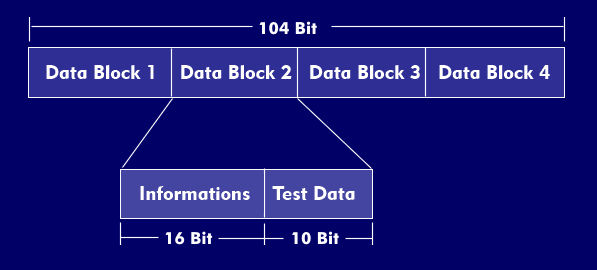radio data system (mobile communications) (RDS)
Radiotext, Radio Data System (RDS), is a standard of the Union of European Broadcasters for the transmission of static information in the form of numeric and alphanumeric data such as the station identification of a radio station, the music title or artist on the displays of radio equipment.
In FM broadcasting, the digital transmission of RDS data takes place on a separate data channel that lies above the transmission bandwidth at 57 kHz. The subcarrier frequency of 57 kHz results from a tripling of the 19 kHz of the pilot tone, which is used in FM broadcasting to obtain the stereo signals. Radio Data System uses quadrature phase shift ke ying( QPSK) as the modulation method, with a transmission rate of 1.187 kbit/s. This data rate corresponds to the subcarrier frequency of 57 kHz. This data rate is equal to the subcarrier frequency divided by 48.
The data is transmitted in groups of four data blocks. Each data block contains 16 bits of information data and 10 bits of check data for forward error correction( FEC). This means that 11.4 groups can be transmitted per second at the data rate specified.
Information transmission in the Radio Data System
Information fields include the program name, the alternative frequencies in the case of several stations of the same program, switching from speech to music, radio text and the announcement for traffic broadcasting. RDS data contains the following data fields:
Alternative Frequency: (AF) In Alternative Frequency, the car radio automatically selects the station with the highest reception field strength. With Enhanced Other Network (EON), when a traffic announcement( TA) is made within a station chain, the radio automatically switches from a station without traffic radio to the corresponding traffic radio station.
Music/Speech (M/S) allows broadcasters to distinguish between music and speech. This technology allows the car radio to automatically adapt its sound range to the corresponding broadcast.
Program Identification (PI) is used to identify the station and Program Service (PS) can be used to show the station name in the display.
Program preselection is possible with the Program Type (PTY) function. With this function, special program contents such as news, sports or rock can be preselected.
The actual radio text function (RT) offers additional information about the titetl of the program, the piece of music, the artist or more.
Traffic Announcement (TA)/Traffic Program (TP) plays traffic news at a preset volume. Other audio sources are muted with this function.
RDS data can only be received by receivers equipped with RDS decoders and is shown on the radio's display. In addition, since 1997 there have been broadcast transmissions of current traffic information on the Traffic Message Channel( TMC) without program interruption.
The U.S. variant of Radio Data System (RDS) is called Radio Broadcast Data System( RBDS).

